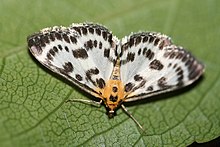Anania hortulata
| Small magpie | |
|---|---|

| |
| Scientific classification | |
| Kingdom: | Animalia |
| Phylum: | Arthropoda |
| Class: | Insecta |
| Order: | Lepidoptera |
| Family: | Crambidae |
| Genus: | Anania |
| Species: | A. hortulata
|
| Binomial name | |
| Anania hortulata | |
| Synonyms | |
|
List
| |
Anania hortulata, the small magpie, is a species of moth of the family Crambidae. It is found in Europe[1] and North America.


The wingspan is 24–28 millimetres (0.94–1.10 in) The head and thorax are deep ochreous-yellow, black-spotted. Forewings are yellowish-white, markings blackish ; base blackish, with two ochreous-yellow marks ; a suffused costal streak ; lines thick, first irregular, second tending to form spots, curved, narrowest below middle ; small orbicular and large round discal spots, touching costal streak ; a terminal fascia tending to form spots, edge parallel to second line. Hind wings with colour, second line, and terminal fascia as in forewings ; a blackish discal spot. The larva is whitish ; dorsal line dull green, white-edged ; head and plate of 2 black.[2]
The moth flies from June to July depending on the location.[3]
The larvae feed on Stachys, mint and nettle.[4]
References[]
- ^ "Anania hortulata (Linnaeus, 1758)". 2.6.2. Fauna Europaea. Retrieved 28 April 2019.
- ^ Meyrick, E., 1895 A Handbook of British Lepidoptera MacMillan, London pdf
 This article incorporates text from this source, which is in the public domain. Keys and description
This article incorporates text from this source, which is in the public domain. Keys and description
- ^ "Anania hortulata". Archived from the original on September 29, 2007. Retrieved August 29, 2008.
- ^ Sterling, Phil; Parsons, Mark; Lewington, Richard (2012). Field Guide to the Micro moths of Great Britain and Ireland. Gillingham, Dorset: British Wildlife Publishing. p. 381.
External links[]
| Wikimedia Commons has media related to Anania hortulata. |
- Pyraustinae
- Moths described in 1758
- Moths of Europe
- Moths of North America
- Taxa named by Carl Linnaeus
- Anania stubs